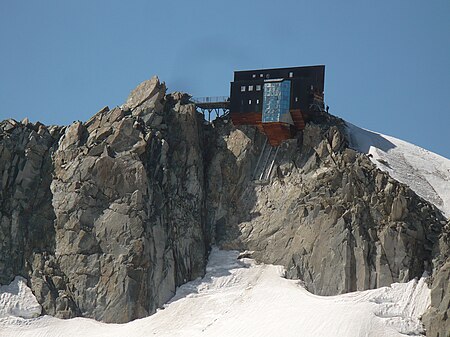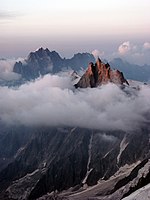Cosmiques Hut

The Cosmiques Hut (French: Refuge des Cosmiques) is a mountain hut in the Mont Blanc massif in the French Alps at an altitude of 3,613 m (11,854 ft). It is a large structure capable of accommodating 148 mountaineers. It was constructed in 1990 on a rock promontory situated between the Col du Midi and the base of the Cosmiques Arête which descends southwards from the Aiguille du Midi. It gives access to a number of classic alpine mountaineering routes, and has proved to be extremely popular with mountaineers, so much so that in the summer months prior booking a few days beforehand is essential in order to secure a bed. The Hut is wardened between mid-February and mid-October. In winter the nearby Abri Simond Hut is left unlocked, although this has no cooking facilities, heating or water.
Excerpt from the Wikipedia article Cosmiques Hut (License: CC BY-SA 3.0, Authors, Images).Cosmiques Hut
Arete des Cosmiques, Bonneville
Geographical coordinates (GPS) Address Phone number External links Nearby Places Show on map
Geographical coordinates (GPS)
| Latitude | Longitude |
|---|---|
| N 45.873055555556 ° | E 6.8855555555556 ° |
Address
Refuge des Cosmiques
Arete des Cosmiques
74400 Bonneville
Auvergne-Rhône-Alpes, France
Open on Google Maps










